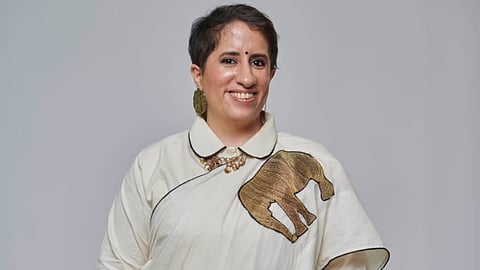Guneet Monga: I am sick of turning women into goddesses
With a filmography that spans genres and geographies, producer Guneet Monga has been pushing boundaries and telling stories that resonate globally. From the Oscar-winning Period. End of Sentence. to The Elephant Whisperers, to critically acclaimed films like Gangs of Wasseypur and The Lunchbox, till the recent adrenaline-pumping actioner, Kill, Monga's Sikhya Entertainment has ushered innovation in storytelling. The production house has recently made a sci-fi police procedural for Zee5, Gyaarah Gyaarah, directed by Umesh Bist, and starring Kritika Kamra, Raghav Juyal, Dhairya Karwa, Nitesh Pandey, and Gautami Kapoor in prominent roles. The show, an official remake of the Korean series Signal, is being appreciated for combining the time travel genre with an investigation thriller, where characters solve decades-old cold cases.
EXCERPTS:
What are your Gyaarah Gyaarah, or 11:11, (superstitions) and favourite police procedurals?
I don't think of 11:11 as a superstition. I view it as magic and a miracle. I also see that magical number as a moment to express gratitude. That was what we tried to retain in the show as well; whenever the clock struck 11:11, some magic took place. Mare of Easttown, Article 15, Delhi Crime, and Talaash are my favourite police procedurals, even Talaash fuses police investigation and supernatural elements.
In Kathal and Gyaarah Gyaarah, you show the good cops as outsiders. Do you believe those absorbed by the system cannot act fairly?
I don't believe in that as such. In Gyaarah Gyaarah, apart from newcomer outsider Yug (Raghav), we have also shown old-timers Vamika (Kritika) and Shaurya (Dhairya) as honest cops. We want to humanise the police characters we write for films. For example, we did a lot of research for Kathal in parts of Uttar Pradesh and Madhya Pradesh, where we found several female cops who were excited to finish work and go home to make samosa for their husbands. We used such quirks in the film and built the character of Mahima (Sanya Malhotra).
Gyaarah Gyaarah is paced like a feature film. Did the thought of making it a film ever cross your mind?
No, the pacing was done in order to end every episode on a cliffhanger. Gyaarah Gyaarah was conceptualised as a series. Maybe after a few more seasons, say seasons 2 and 3, we may end the story in a film instead of a season 4.
Are you confirming exclusively with us that the series is getting renewed?
That's how we dreamers think (laughs). There are always talks about new seasons, but it's the streamer's call.
Did director Umesh Bist convince you with his pitch, or did he ask you to watch Signal?
Actually, it happened the other way around. We loved Signal. We struggled for over a year and a half to acquire its remake rights. We then took to Umesh, as we loved working with him in Pagglait. Umesh, along with writers Puja Banerji and Sunjoy Shekhar, did a fantastic job Indianising the show.
Why and how was Uttarakhand chosen as the setting for Gyaarah Gyaarah?
How we finalised Uttarakhand is an interesting story. We first wanted to set the story in Punjab or Rajasthan, for the unique colours these regions provide. Only later did Uttarakhand, Dehradun, and the mountains happen. The winter mist and the mountains of Uttarakhand added to the mystery of the show and helped bring out great visuals. The mountains of the state are an important element of the series.
On another occasion, you said Sikhya Entertainment aims to take Indian stories to the world. How do you define Indian stories?
We want to tell the stories of our land, not necessarily in Hindi. Our films like The Lunchbox, The Elephant Whisperers, Masaan, Kill, and Gangs of Wasseypur are stories of different regions of India. Several foreigners told me they knew India only through The Lunchbox. Likewise, I have heard so many people coming to India solely to meet Raghu and Ammu (the elephants in The Elephant Whisperers). So I would define Indian stories as raw, authentic, and original. Showing us (Indians) on the larger canvas is our superpower as storytellers. The more local and original the content, the greater the reach would be globally. Life is too short, and there is so much to be done. I like to be a bridge that constantly takes India to the world.
Being a woman producer, what is that extra lens you wear while filtering content while portraying women on screen?
I don't believe in showing women in a certain colour, and I am sick of always making them into goddesses. I feel women should be able to make all kinds of films and portray all kinds of roles, breaking stereotypes. Whenever it comes to showing a female body through a camera, there is always a subtext that you play into. Even in an otherwise male-dominated, testosterone-heavy action film like Kill, the biggest kills are given to women; that's the subtext we wanted to convey. There is always a conversation between me and the directors on how the camera moves and what emotions we want to titillate. I don't encourage the exploitation of women, at the same time, nor do I say whitewash women's reputations, since we come in all forms and colours. It has to be taught that a film is not your 'titillation space'; just tell your stories.


